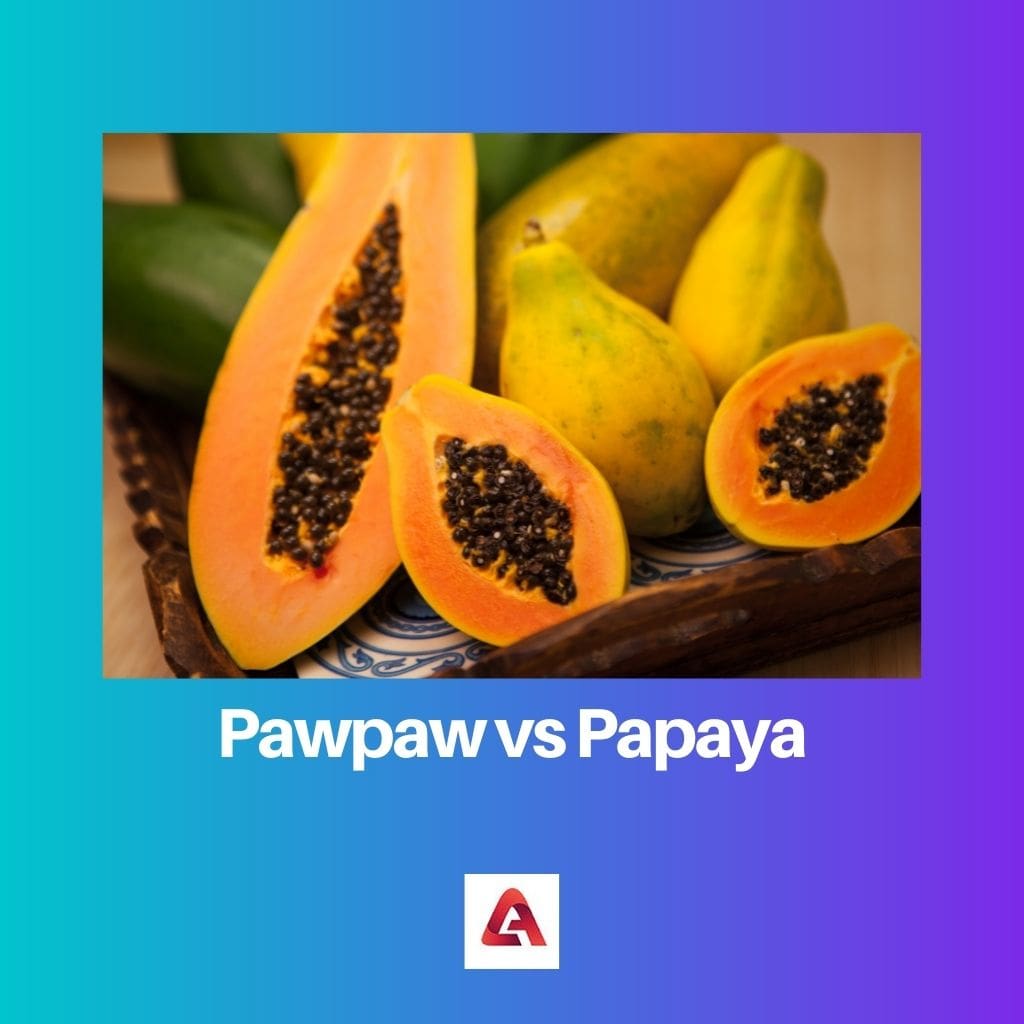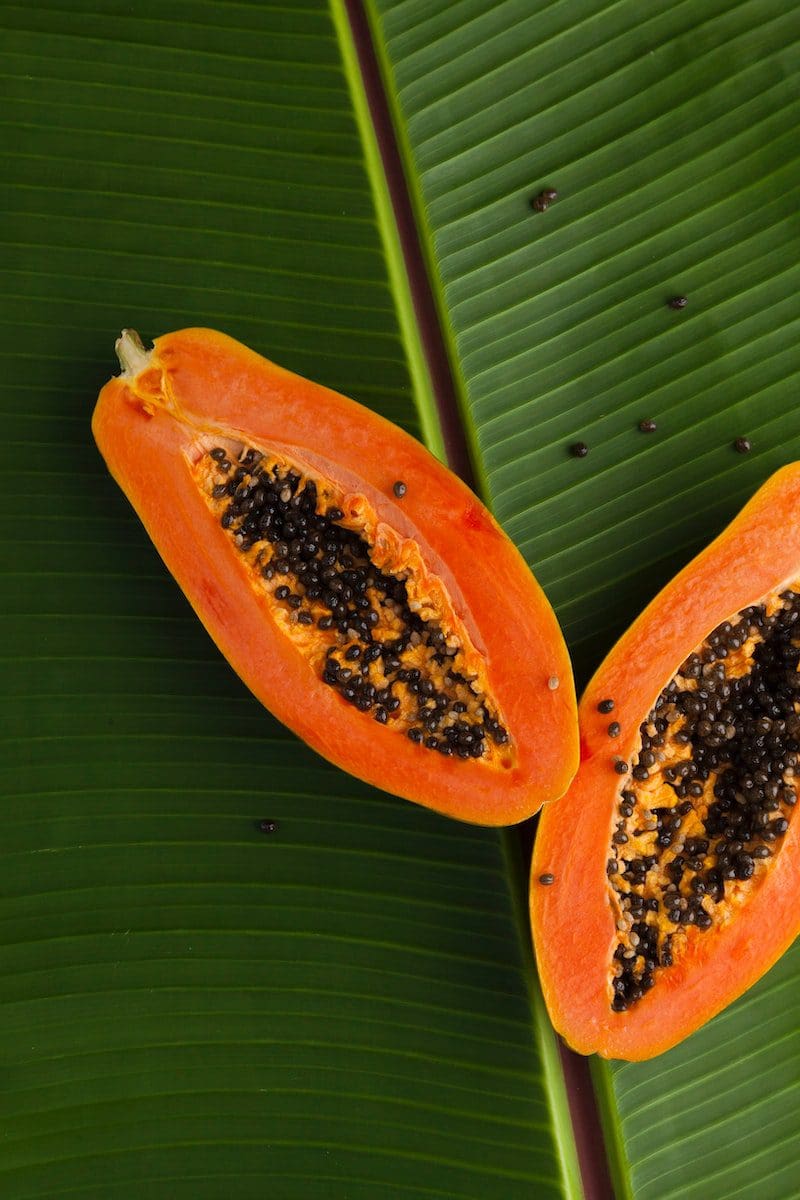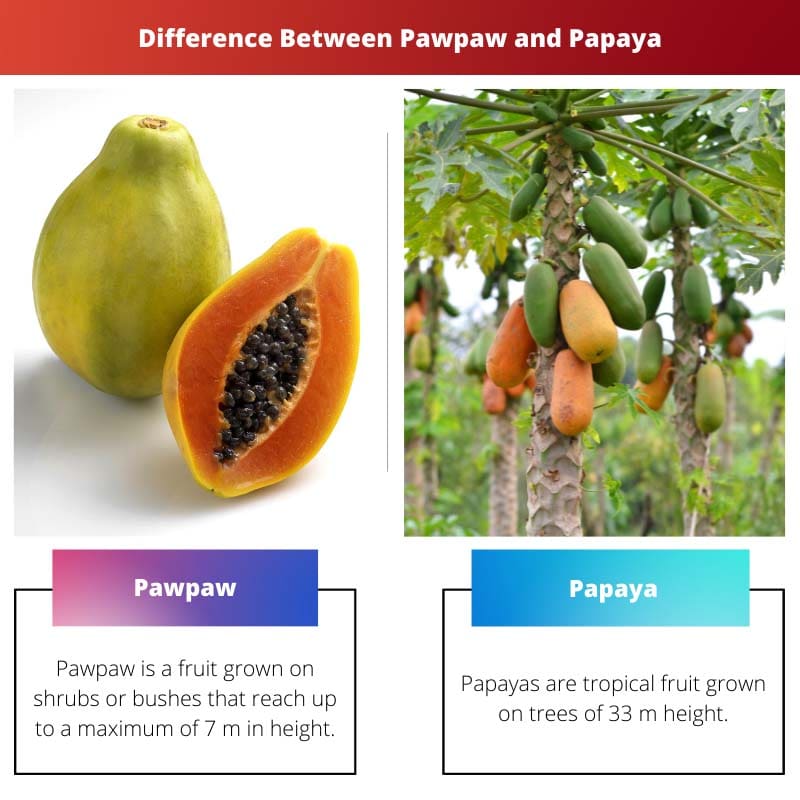Ever entered a shop to see papayas being kept on two racks? The two racks have the same fruit but in different colors and shapes.
Have you ever wondered if they were different or dismissed the thought thinking all papayas don’t grow in the same shape or size?
The fact is that the fruits in the two racks are indeed different, not only in their size and shape but also in their taste and uses. Not just this, but they grow in different plants and also have different medicinal values.
Key Takeaways
- Pawpaw is a fruit native to North America, from the Asimina triloba tree, with a custard-like texture and a flavor reminiscent of banana and melon; papaya is a tropical fruit from the Carica papaya plant, native to Central America, with sweet, juicy flesh and a distinct aroma.
- Pawpaw fruits are smaller and oval-shaped, with a greenish-yellow skin; papayas are larger and elongated, with green to orange-red skin when ripe.
- Pawpaw trees grow in temperate climates and produce fruit in the fall; papaya plants thrive in tropical climates and bear fruit throughout the year.
Pawpaw vs. Papaya
Pawpaw is a fruit native to North America with a sweet and tropical flavor, similar to a combination of mango, banana, and pineapple. Papaya is a yellowish-orange skin when ripe and soft, juicy, bright orange flesh with small black seeds in the center, with a texture that is similar to a melon.

Pawpaw is a spherical and rather large-sized fruit grown on shrubs or bushes, completely different from the plant papaya is grown on. They have a rather mild and bland taste, like bananas.
On the other hand, Papaya is oval-shaped but smaller than pawpaw. It is a tropical fruit grown on tropical trees in warm areas.
They have a refreshing taste, almost blending mangoes and cantaloupe.
Comparison Table
| Parameters of Comparison | Pawpaw | Papaya |
|---|---|---|
| Shape and size | Spherical and large | Oval and small |
| Colour of skin | Green with yellow patches | Orange or reddish |
| Colour of flesh | Yellow flesh | Red flesh |
| Taste | It has a rather bland taste | It has a tropical taste |
| Used in | Used raw, in fruit salads, for pickles, etc. | Used dried smoothies, fruit salads, desserts, etc. |
| Region for growth | Grown in temperate hilly regions | Grown in warm or tropical climate areas |
| Plant | It is a shrub or a bush with a maximum height of 7 m. | It is a tropical tree that grows up to 33 m in height. |
| Best for | It helps with digestion by breaking down the gluten | Menstruation pain, reducing stress and signs of aging |
What is Pawpaw?
Pawpaw is a fruit grown on shrubs or bushes that reach a maximum of 7 m in height. Since they are temperate fruits, they should be grown in temperate hilly regions for the best quality.
They are spherical and large. They are seen to be green with yellow patches all over them in their ripe form and have yellow flesh.
Papaws have a mild and bland taste, like bananas. This is why they are treated as a vegetable and used in pickles rather than smoothies and desserts.
Papaws are a useful medicinal plant, much like papaya.
Since they grow on different plants, they have different properties. Papaws are an ailment for digestion problems as they help break down gluten.

What is Papaya?
Papayas are tropical fruit grown on trees 33 m in height. They are grown in warm and tropical areas since that is where they grow the best.
They are oval-shaped and smaller in size than papaws. Their skin is orange to reddish when ripe and green when raw.
This is why many get confused between papaws and papayas. Papayas taste rich and tropical, almost like a crossover between mangoes and cantaloupes.
Therefore they are used in delicious treats like smoothies, fruit salads, and desserts or after being dried. Papayas hold great medicinal value as well.
They help with menstrual pain for women and also help in relieving stress. Taking papayas regularly during this time of the year can benefit an individual’s health and mind.

Main Differences Between Pawpaw and Papaya
- The shape and size of the pawpaw and papaya are contrastingly different. When ripe, pawpaw is spherical and comparatively larger than papaya. The papaya is oval-shaped and is smaller in size.
- When ripe, the pawpaw is green with yellow patches or completely yellow or green. On the other hand, fully ripe papaya is seen to be orange or reddish.
- Even the flesh of the two has a different color, making it easier to differentiate. Pawpaw has yellow flesh, whereas papaya has red flesh. This is the case when they are ripe.
- Pawpaw has a rather bland and mild taste, like bananas. But papaya, on the other hand, has a rich and tropical taste, almost like a crossover between mango and cantaloupe.
- Since they differ in taste, they are also used in different dishes and ways. Pawpaw is used raw for its bland taste and in fruit salads, pickles, etc., whereas papayas are used dried for fruit salads, smoothies, and desserts.
- Pawpaw is grown in temperate hilly regions, whereas papaya, a tropical fruit, is grown in warm and tropical areas.
- Papaya is grown on a tree of 33 m, whereas pawpaw is grown on shrubs or bushes that reach a maximum height of 7 m.
- Since they are different plants, they also hold different medicinal values. Papayas help with menstrual pain and relieve stress, whereas pawpaw helps with digestion problems by breaking down gluten.

- http://yadda.icm.edu.pl/yadda/element/bwmeta1.element.agro-article-abd5eb01-752a-4d2a-8930-fcf6310ab1d2/c/Seedling_emergence_and.pdf
- https://www.cabdirect.org/cabdirect/abstract/19701606658

The description of the taste and uses of both fruits is very well written. I appreciate the level of detail provided.
Yes, this detailed description was very engaging and educational. I feel more knowledgeable about these fruits after reading this article.
I found the article highly informative and detailed. It’s surprising how fruits that look alike can be so different in nature and uses.
Yes, it’s fascinating to learn about these differences, I’m impressed with the depth of information shared.
I’m amazed at how different the properties of both fruits are, this is very valuable information for anyone interested in dietary and medicinal qualities of fruits.
Indeed, we overlook how fruits that appear similar can have such distinct characteristics. This article has been eye-opening.
The medicinal values and different uses of both fruits are great to know, but it would benefit from contrasting it with other tropical or temperate fruits.
I agree, they are interesting fruits, but a comparison with other similar fruits would be very insightful.
That’s a good point, it would give readers more context if other fruits were included in the comparison.
The comparison table is really helpful to understand the differences between Pawpaw and Papaya, I never realized how distinct they were until I read this article. I’m really excited to try both fruits and find out the taste differences!
I completely agree with you, the descriptions are very detailed and informative. I’m also curious to try both now!
The article brings new insights into fruits most people don’t think too deeply about. However, it could have been more engaging if a lighter tone was used.
I found the straightforward information more appealing, but I see how a lighter tone could make it more enjoyable for others.
I see your point, it’s a bit heavy on the facts and could use a touch of humor or more engaging language.
This article presents the information quite objectively and scientifically. I think it makes the content feel a bit dry, but I can see the appeal for some readers.
I understand what you mean, the scientific approach has benefits but might feel less engaging to a wider audience.
Yes, for those who are interested in very specific details, the scientific approach is beneficial.
I appreciate the detailed description of the fruits and their differences. It’s a great resource for anyone looking to diversify their fruit intake.
Absolutely, it’s a very comprehensive guide to these fruits and their properties.
The medicinal values of both fruits are exceptional, and I appreciate the detailed breakdown of their uses. It’s valuable information for health-conscious individuals.
I completely agree, it’s very interesting to know how our dietary choices can have medicinal benefits.
Although the article presents compelling information, it feels too lengthy and detailed. It could have been more concise and straight to the point.
I don’t mind the length, I found it all quite interesting.
I kind of agree, the article could have been more succinct but it does provide important facts.